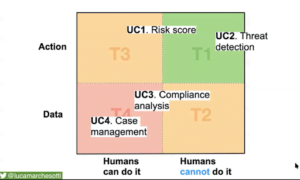Can AI replace cybersecurity professionals?
An article in Silicon Republic reports that Europe is facing a shortage of cybersecurity professionals. With “Ireland needing around 10,000 infosec workers to plug the gap and Europe as a whole needing close to 200,000...

An article in Silicon Republic reports that Europe is facing a shortage of cybersecurity professionals. With “Ireland needing around 10,000 infosec workers to plug the gap and Europe as a whole needing close to 200,000”, the situation is critical. Our team at Sparkd thinks that the application of AI in cybersecurity could help address this issue.
Do we believe that AI can replace cybersecurity professionals? Absolutely not. We believe that while companies invest in training new cybersecurity experts, AI could help maximise the effort of those already working in the field. In fact, AI can be implemented to speed up tasks which would otherwise be very time-consuming for humans to carry out, leaving more time for cybersecurity experts to deal with the most dangerous cyber threats.
To better explain why we believe AI could partly make up for the shortage of cybersecurity professionals in the short term, we analysed 4 use cases of AI in cybersecurity. We then used the AI value matrix to assess house these use cases could optimise existing cybersecurity resources.
4 Use Cases of AI in cybersecurity
There are many examples of AI applications in cybersecurity. This article presents 4 Use cases that could help companies make the most out of their cybersecurity team while looking for extra staff. The 4 use cases are:
- Network security/ vulnerability detection
- Cyber threat detection
- Compliance analysis.
- Case management
-
Network security/ vulnerability detection
With remote working on the rise since the beginning of the Covid pandemic, ensuring the security of a company’s network is an even bigger challenge. Despite the wide variety of antivirus and VPN software available on the market, new kinds of malware and ransomware keep popping up at an alarming rate. So much so that vendors are not always able to promptly implement updates to respond to these new threats. It is, therefore, important to prevent cyber attacks by ensuring that all the devices connected to your network are equipped with the highest possible level of security. AI can monitor all the endpoints within your network and flag those which could be easy entry points for cyber threats.
2. Cyber threat detection
AI can analyse all the data travelling in and out of your network and detect if it represents a cyber threat. Once a cyber threat is detected, the AI algorithm can either take specific actions or report the issue to your cybersecurity professionals to address it. In doing so, the AI algorithm identifies real threats from false positives, allowing your team to focus only on real threats.
3. Compliance analysis
Experienced cybersecurity analysts investigate incidents, detect weak links within cyberspace, and help the organisation comply with government regulations. However, this process requires considerable time, which your company might not afford. Even more so if your cybersecurity department is understaffed. AI algorithms can perform the same tasks in less time, adding value and resources to your company’s cybersecurity team.
4. Case management
AI helps your team manage the workflow of cybersecurity cases throughout your organisation and performs tasks that are usually very time-consuming for employees. By automating your case management system, you will save time, costs, and resources. As a result, your cybersecurity experts can focus on the most pressing issues.
What AI application(s) will bring more value to my cybersecurity team?
Provided that each company has different needs and priorities, AI brings value to cybersecurity teams in many different ways. So, the question is, how can you understand which AI application is more valuable to your company?
The first step in understanding if and how AI can help your team is to analyse your needs and resources. When doing so, keep in mind that AI has two main purposes:
- Complete tasks which are very time-consuming for humans to carry out
- Complete tasks which humans cannot carry out at all
To simplify this assessment process, we use a tool called AI Value Matrix. You can download this tool here and read more about it here. We used the AI Value Matrix to assess what value the 4 Use Cases of AI in cybersecurity presented in this article could bring to a company. As part of our assessment, we assumed the company has not yet implemented AI, and its cybersecurity team is understaffed. We also assumed that the company’s priority is maximising human resources while efficiently protecting the company from cyber threats. You can find the results of our assessment in the infographic below where:
- UC1 = Network security/ vulnerability detection
- UC2 = Cyber threat detection
- UC3 = Compliance analysis
- UC4 = Case management

- The green quadrant (T1) displays the area where AI can bring significant value to the company.
- The red quadrant (T4) indicates the area where AI brings the least value, meaning that humans can handle these tasks quite well.
- The orange quadrants (T2 and T3) represent areas where AI can still bring value, but not as much as the application displayed in quadrant T1
Following this assessment, we can say that implementing AI to detect cyber threats is the best solution for a company that needs to maximise its human resources while addressing one of its main cybersecurity challenges.
Can AI help address the shortage of cybersecurity professionals in Europe?
Yes. AI can definitely help address the shortage of cybersecurity professionals. As we mentioned before, AI will never replace cybersecurity experts. Still, it can help them focus on important challenges by allowing AI to complete tasks which are too complex or time-consuming for staff. Colleges and other educational institutions in Ireland and other European countries responded to the high demand for cybersecurity professionals by implementing a wide range of cybersecurity courses. At the same time, companies are investing in upskilling their existing staff in cybersecurity. But there still remains a problem right now that needs an immediate solution. These initiatives will bring results in the medium-long term, but most companies cannot afford to wait for the next generation of cybersecurity experts to graduate. AI could offer a viable and fast solution for all companies needing extra cybersecurity expertise right now.
Author Manuela Armini



